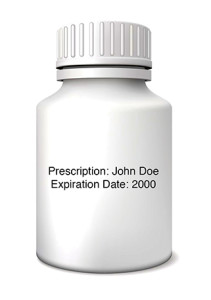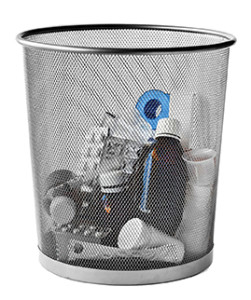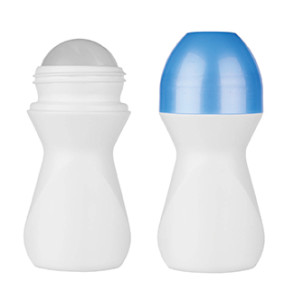Organize Your Medicine Cabinet
Posted on January 30, 2016 by bob in Features
 Pity the poor medicine cabinet. Its shelves are often stocked with useless items — the lip balm you bought 15 winters ago but never bothered to get rid of, the expired medications you’re hanging onto because…why were you hanging onto them? And that smelly lotion your niece gave you for Christmas. You just don’t have the heart to throw it out.
Pity the poor medicine cabinet. Its shelves are often stocked with useless items — the lip balm you bought 15 winters ago but never bothered to get rid of, the expired medications you’re hanging onto because…why were you hanging onto them? And that smelly lotion your niece gave you for Christmas. You just don’t have the heart to throw it out.
“Medicine cabinets are like attics or basements,” says organization expert Vickie Dellaquila, a Certified Professional Organizer and author of Don’t Toss My Memories in the Trash. “Stuff goes in there and you don’t think about it again. You wind up with seven tweezers and Band-Aids so old that they don’t stick to anything anymore.”
Fact: A well-organized medicine cabinet can save you time and make your house a lot safer place to be, especially if you have grandchildren visiting frequently. How to organize it? Home and lifestyle expert Laura Dellutri, author of Speed Cleaning 101: Cut Your Cleaning Time in Half!, offers these tips to guide us to creating a well organized medicine cabinet. Here’s what you need to know:
Start from Scratch
1) Take everything out of your medicine chest, and sort it into piles. In one, place all prescription medicines, in another, all over-the-counter pain relievers, medicines, creams, and ointments. Group all first-aid products together, and then any other items you have into another pile.
2) Examine all prescription medicine to see if it is expired. If it is (or if it is more than one year old), get  rid of it. Do not throw it in the garbage, where you might invite people looking for narcotics to go scrounging. Do not flush it down the toilet, which may pollute the water supply. Instead, Dellaquila says, check with city hall to see if there is a “take back drugs” day on the community calendar. If not, call the police department, which may allow you to turn in drugs there. Your local pharmacy or hospital may take back expired drugs. Or, mix your medications with used coffee grounds or kitty litter and put the result in the garbage. Most narcotics users won’t go through such substances to find drugs.
rid of it. Do not throw it in the garbage, where you might invite people looking for narcotics to go scrounging. Do not flush it down the toilet, which may pollute the water supply. Instead, Dellaquila says, check with city hall to see if there is a “take back drugs” day on the community calendar. If not, call the police department, which may allow you to turn in drugs there. Your local pharmacy or hospital may take back expired drugs. Or, mix your medications with used coffee grounds or kitty litter and put the result in the garbage. Most narcotics users won’t go through such substances to find drugs.
3) Examine your over-the-counter products to see what’s expired. If the item has no date on it, make an honest assessment. If it looks so old that it can’t be any good anymore, it probably isn’t. Open your box of adhesive bandages — do they look fresh and usable? If not, toss and replace them on your next shopping trip.
A Shelf-by-Shelf Guide to Organizing the Items You Keep
Once you have isolated what you want to save, organize your cabinet like this:
Top shelf: Here, store your first-aid supplies (Band-Aids, gauze, cotton pads), as well as items that are hazardous and not used that frequently — rubbing alcohol, peroxide, antibiotic creams.
Dellaquila suggests that all grandparents add to this shelf Syrup of Ipecac, an important product to have on hand in case a visiting grandchild ingests something poisonous and you need to induce them to vomit.
Second shelf down: Think everyday stuff, says Dellutri. Eye wash, mouthwash, antacids, cold medicines — all over-the-counter products. If you can fit it on this shelf, night creams, moisturizers, make-up remover, and nail polish remover should live here as well.
Third shelf down: Use this for your medications. If you have several different medications, Dellutri suggests that you arrange them from left to right, starting with the most current prescription so that you are keeping track of which ones need re-filling and which ones are in danger of expiring. Periodically, pull the pill bottle, check it, and get rid of it if it’s out of date. That way you’ll be keeping up on a regular basis.
Bottom shelf: Here, keep handy the things you use every day: toothpaste, deodorant, toothbrush (if you  can fit it). Group like things together, says Dellaquila. For example, keep tweezers, nail clippers, emery boards, and hand lotion together in a little bin. In another, store cold medications, and use another for antacids or other stomach relief. If you choose to keep your make-up in the cabinet, store it in an acrylic organizer that lets you stand lipsticks up and keep mascara and liners where you can easily see them.
can fit it). Group like things together, says Dellaquila. For example, keep tweezers, nail clippers, emery boards, and hand lotion together in a little bin. In another, store cold medications, and use another for antacids or other stomach relief. If you choose to keep your make-up in the cabinet, store it in an acrylic organizer that lets you stand lipsticks up and keep mascara and liners where you can easily see them.
If yours is a small medicine chest and you have overflow, Dellaquila suggests an over-the-door shoe rack, which can be used to store items that don’t fit in your medicine cabinet.
Once your medicine cabinet is organized, be careful about filling it too full. “Less is more,” says Dellaquila. “Think before you bring things in to fill it up again.”
Courtesy: grandparents.com









